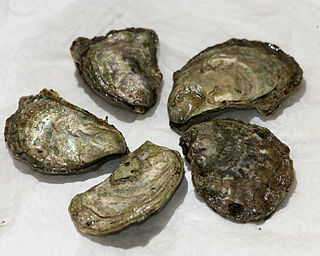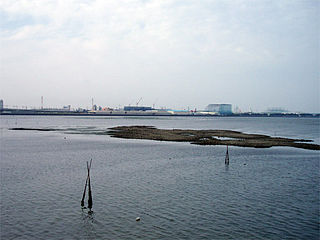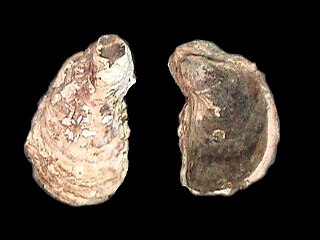
An estuary is a partially enclosed coastal body of brackish water with one or more rivers or streams flowing into it, and with a free connection to the open sea. Estuaries form a transition zone between river environments and maritime environments and are an example of an ecotone. Estuaries are subject both to marine influences such as tides, waves, and the influx of saline water, and to fluvial influences such as flows of freshwater and sediment. The mixing of seawater and freshwater provides high levels of nutrients both in the water column and in sediment, making estuaries among the most productive natural habitats in the world.

Oyster is the common name for a number of different families of salt-water bivalve molluscs that live in marine or brackish habitats. In some species, the valves are highly calcified, and many are somewhat irregular in shape. Many, but not all oysters are in the superfamily Ostreoidea.

The eastern oyster —also called the Atlantic oyster, American oyster, or East Coast oyster—is a species of true oyster native to eastern North and South America. Other names in local or culinary use include the Wellfleet oyster, Virginia oyster, Malpeque oyster, Blue Pointoyster, Chesapeake Bay oyster, and Apalachicola oyster. C. virginica ranges from northern New Brunswick south through parts of the West Indies to Venezuela. It is farmed in all of the Maritime provinces of Canada and all Eastern Seaboard and Gulf states of the United States, as well as Puget Sound, Washington, where it is known as the Totten Inlet Virginica. It was introduced to the Hawaiian Islands in the nineteenth century and is common in Pearl Harbor.

Crassostrea is a genus of true oysters containing some of the most important oysters used for food. Some species in the genus have been moved to the genus Magallana.

The Ostreidae, the true oysters, include most species of molluscs commonly consumed as oysters. Pearl oysters are not true oysters, and belong to the order Pteriida.
Perkinsus marinus is a species of alveolate belonging to the phylum Perkinsozoa. It is similar to a dinoflagellate. It is known as a prevalent pathogen of oysters, causing massive mortality in oyster populations. The disease it causes is known as dermo or perkinsosis, and is characterized by the degradation of oyster tissues. The genome of this species has been sequenced.

The Pacific oyster, Japanese oyster, or Miyagi oyster, is an oyster native to the Pacific coast of Asia. It has become an introduced species in North America, Australia, Europe, and New Zealand.

Oyster farming is an aquaculture practice in which oysters are bred and raised mainly for their pearls, shells and inner organ tissue, which is eaten. Oyster farming was practiced by the ancient Romans as early as the 1st century BC on the Italian peninsula and later in Britain for export to Rome. The French oyster industry has relied on aquacultured oysters since the late 18th century.

Ostrea edulis, commonly known as the European flat oyster, is a species of oyster native to Europe. In Britain and Ireland, regional names include Colchester native oyster, mud oyster, or edible oyster. In France, Ostrea edulis are known as huîtres plates except for those that come from the Belon River estuary in Brittany, France, which are known as Belons.

Netarts Bay is an estuarine bay on the northern Oregon Coast of the U.S. state of Oregon, located about 5 miles (8.0 km) southwest of Tillamook. The unincorporated community of Netarts is located on the north end of the bay and Netarts Bay Shellfish Preserve, managed by Oregon Department of Fish and Wildlife, is located on the south side of the bay. The sand spit on the west side of Netarts bay is part of Cape Lookout State Park.

Ostrea lurida, common name the Olympia oyster, after Olympia, Washington in the Puget Sound area, is a species of edible oyster, a marine bivalve mollusk in the family Ostreidae. This species occurs on the northern Pacific coast of North America. Over the years the role of this edible species of oyster has been partly displaced by the cultivation of non-native edible oyster species.
Haplosporidium nelsoni is a pathogen of oysters that originally caused oyster populations to experience high mortality rates in the 1950s, and still is quite prevalent today. The disease caused by H. nelsoni is also known as MSX. MSX is thought to have been introduced by experimental transfers of the Pacific oyster, which is resistant to this disease.

Oyster reef restoration refers to the reparation and reconstruction of degraded oyster reefs. Environmental changes, modern fishing practices, over harvesting, water pollution, and other factors, have resulted in damage, disease, and ultimately, a large decline in global population and prevalence of oyster habitats. Aside from ecological importance, oyster farming is an important industry in many regions around the world. Both natural and artificial materials have been used in efforts to increase population and regenerate reefs.
Bonamia ostreae is a parasitic Rhizaria in the phylum Haplosporidia that can cause lethal infections in shellfish, particularly the European flat oyster, Ostrea edulis. Infection in oysters rarely results in clinical signs of disease and often the only indication of the infection is increased mortality. The Australian flat oyster, Ostrea angasi, has been infected with two similar Bonamia parasites, Bonamia exitiosa and B. roughleyi.

Saccostrea cucullata, the hooded oyster or Natal rock oyster, is a species of rock oyster found mainly in the Indo-Pacific Ocean.

Shell growth in estuaries is an aspect of marine biology that has attracted a number of scientific research studies. Many groups of marine organisms produce calcified exoskeletons, commonly known as shells, hard calcium carbonate structures which the organisms rely on for various specialized structural and defensive purposes. The rate at which these shells form is greatly influenced by physical and chemical characteristics of the water in which these organisms live. Estuaries are dynamic habitats which expose their inhabitants to a wide array of rapidly changing physical conditions, exaggerating the differences in physical and chemical properties of the water.
The Suminoe oyster, is a species of true oyster which inhabits intertidal hard grounds and substrate, as well as muddy creeks of warm estuaries throughout the western Pacific. It is large and flat in appearance and almost identical in gross morphology to Crassostrea virginica.

The term oyster reef refers to dense aggregations of oysters that form large colonial communities. Because oyster larvae need to settle on hard substrates, new oyster reefs may form on stone or other hard marine debris. Eventually the oyster reef will propagate by spat settling on the shells of older or nonliving oysters. The dense aggregations of oysters are often referred to as an oyster reef, oyster bed, oyster bank, oyster bottom, or oyster bar interchangeably. These terms are not well defined and often regionally restricted.

Crassostrea rhizophorae, also known as the mangrove cupped oyster, is a species of bivalves in the family Ostreidae. C. rhizophorae is one of the predominating oyster species in the South Atlantic, specifically in Central and South America. It is often found in the vast mangrove ecosystem along the coast of Brazil.

Atrina pectinata is a species of bivalves belonging to the family Pinnidae.















